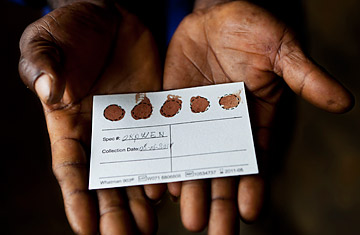
Hunters collect blood from animals they've killed and turn it in for research.
Junior creeps through the tropical forest, searching for his prey. The hardwood trees in southern Cameroon are some of the most valuable in Central Africa, their branches towering above 50 ft. (15 m), but Junior's eyes are on the jungle floor. He's a hunter, and his target is bush meat: wild forest animals like porcupines, the cat-size antelopes called dik-diks, perhaps even monkeys. One would be enough to feed his family for a couple of days, or he could sell it to truckers passing along the new, Chinese-made logging roads that cut through this once untouched part of the forest. When Junior arrives at one of his traps after hours of walking, though, he kneels to find that the wire snare has snapped but is empty. Something living has already come and gone.
Nathan Wolfe leans over Junior and examines the spent trap. A 41-year-old with close-cropped black hair and sleepy Buddha eyes, Wolfe is a hunter in this forest as well, though one of a different sort. He stalks viruses--new ones--and the Cameroonian forest is one of the best places to find them. As the founder and head of Global Viral Forecasting (GVF), Wolfe has set up projects in Africa, Southeast Asia and southern China--all hot spots where humans and wild animals intermingle and new viruses can leap from one species to another.
Wolfe's big idea is as simple as it is ambitious. Pandemics and outbreaks of new infectious diseases usually begin when a novel microbe in an animal mutates and passes to a human being who lacks immunity to it. HIV, SARS, swine flu--they all began in animals. But instead of waiting for viruses to appear in humans, Wolfe is going on the offensive, using hunters like Junior to gather blood from animals that Wolfe and his colleagues can screen for unknown pathogens. "This is the sort of place where people can have contact with animals and their viruses and spark a real pandemic," he says. "It all comes together here."
This is a revolution in epidemiology--working to predict and prevent rather than simply respond to pandemics. The world is more vulnerable to infectious new pathogens than ever. For one thing, there are simply more of us--7 billion, to be exact--often packed into dense cities, where an aggressive disease could spread fast. We're also more connected; thanks to air travel, there's barely a spot on this planet, including the deep forests of Cameroon, that isn't within 24 hours of a major city. A new disease that might have burned out in a rural village years ago now stands a better chance of finding fresh victims. Meanwhile, as we clear-cut forests and expand into what was once wilderness, we expose ourselves to new animals and microbes.
The panic, chaos and death in the recent film Contagion--for which Wolfe served as a technical adviser--aren't exaggerations. "We are at greater risk because of our greater interconnectedness," says Dr. Donald Burke, dean of the graduate school of public health at the University of Pittsburgh and one of Wolfe's mentors. "That's why we need to get better at figuring out where these things start." If we fail, Hollywood's take on the problem could turn out to be a portent of what we'll all experience.
